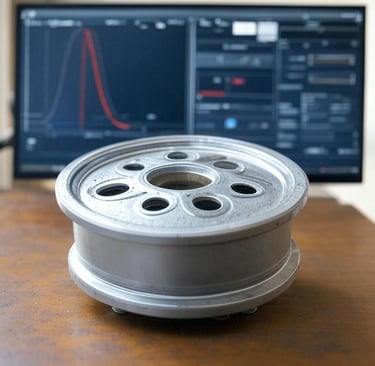Small Manufacturers, Big Mistakes – Why Skipping Material Characterization is Costing You!
What happens when small manufacturers cut corners on material testing? A seemingly minor oversight can lead to catastrophic product failures, costly recalls, and a damaged reputation. From cracked control arms in automobiles to failing industrial valves, real-world cases prove that inadequate testing can be a manufacturer’s worst nightmare. In this blog, we explore how skipping essential material characterization can backfire—and why smart manufacturers invest in thorough testing to ensure quality, reliability, and long-term success. Don’t let short-term savings turn into long-term losses!
S.Puchhala
3/5/2025


The Costly Oversight of Ignoring Material Testing
For small and medium manufacturers, product failure is not just a setback—it’s a financial nightmare. From unexpected component breakdowns to warranty claims and recalls, the absence of proper material testing can lead to significant losses. While many manufacturers focus on design and production efficiency, they often overlook the foundation of product durability—material performance. Without thorough material characterization, products are at risk of premature failure under heat, stress, fatigue, or corrosion. The question is: can your business afford these risks?
What Happens When You Skip Material Testing?
Imagine this: A small-scale automotive parts manufacturer in India, eager to reduce costs, skips extensive fatigue testing on a batch of aluminum control arms. Everything seems fine initially, and the product reaches the market. However, within a year, reports of premature failures start emerging cracks forming under cyclic loads, leading to safety concerns and warranty claims.
Expensive recalls that eat into your profits.
Damaged brand reputation, making future sales harder.
R&D setbacks, forcing redesigns that delay market entry.
One real-world example is a small Indian manufacturer of industrial valves that faced major setbacks due to undetected casting defects. A batch of valves, used in high-pressure steam applications, started failing prematurely due to improper material composition and insufficient fatigue or containment testing. The failures led to safety concerns, contract losses, and costly re-engineering efforts.
Skipping material testing might seem like a cost-cutting measure, but in reality, it’s a high-risk gamble that can result in financial and reputational damage. In contrast, companies that invest in reliable material characterization ensure superior product quality, longer lifespan, and market competitiveness.
Smart Material Testing to Optimize Performance & Reduce Costs
The good news? These costly failures are 100% avoidable. Material testing provides data-driven insights to ensure your components withstand real-world conditions before they reach the market. Here’s how:
Microstructure & Metallurgical Analysis – Detect defects early and optimize material selection for longevity.
Mechanical Property Testing – Assess tensile strength, hardness, and fatigue resistance to prevent structural failures.
Corrosion & Thermal Analysis – Understand how materials respond to environmental factors and high temperatures.
Material Cards for Simulation – Feed accurate data into numerical simulations to predict performance before manufacturing and series production.
By integrating material testing into your product development workflow, you can reduce trial-and-error, lower development costs, and accelerate time-to-market.
The result? A stronger, more durable product that saves you money instead of costing you millions.
Invest in Material Testing, Secure Competitive Edge
In today’s competitive market, small and medium manufacturers can’t afford costly failures. Material testing isn’t just an extra step—it’s a profit-saving strategy that ensures your product performs reliably in the field.
Don’t let unseen weaknesses derail your success. Test smart, develop better, and stay ahead of the competition!
